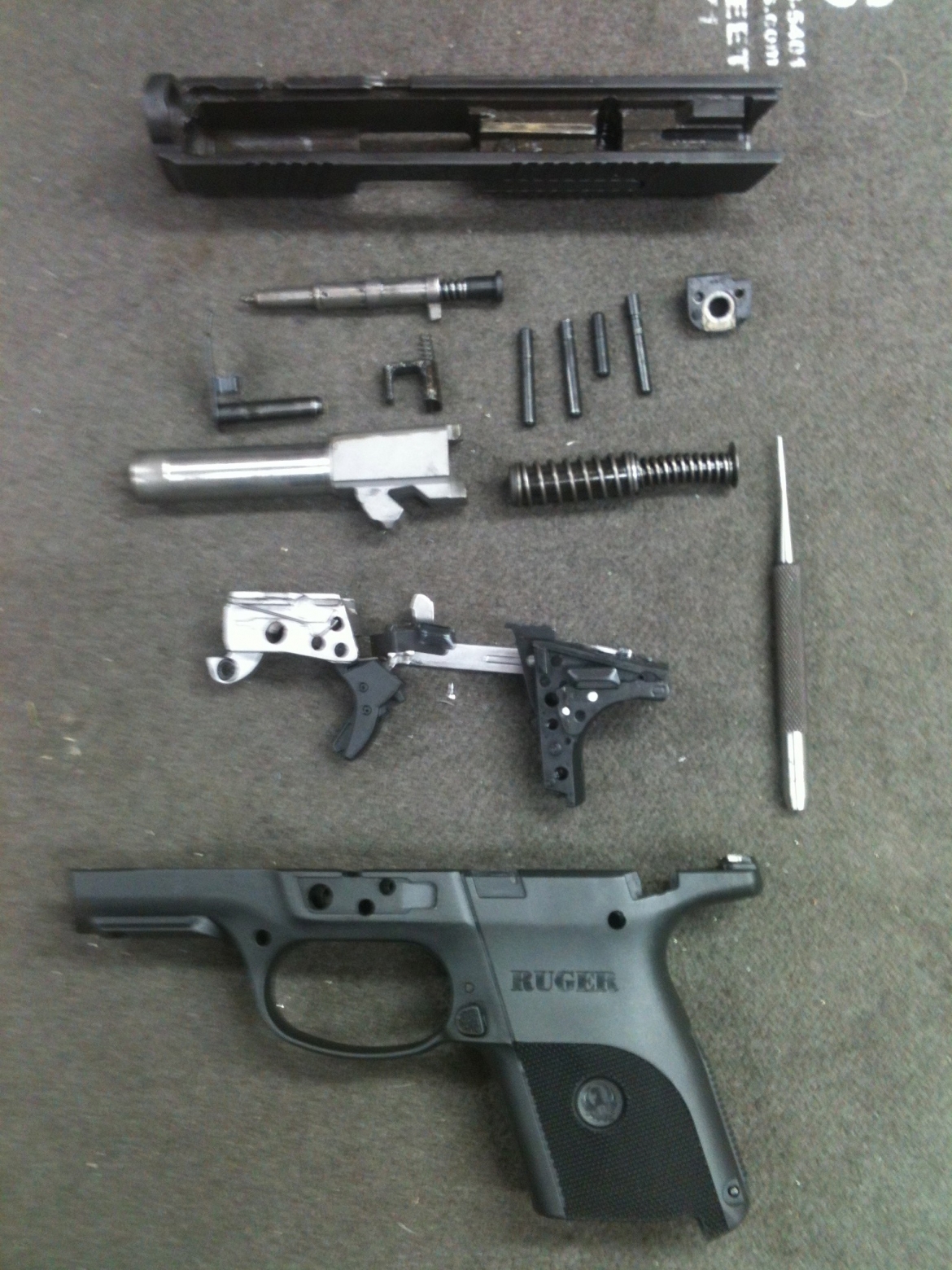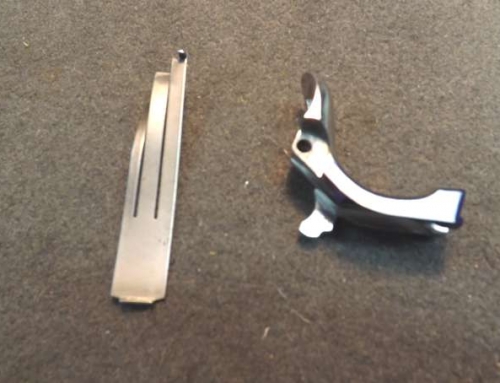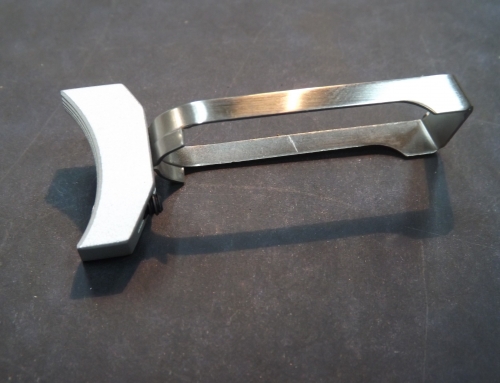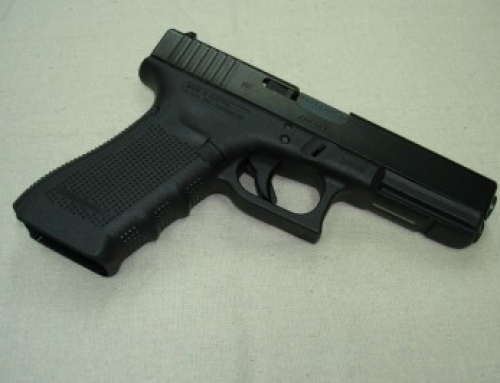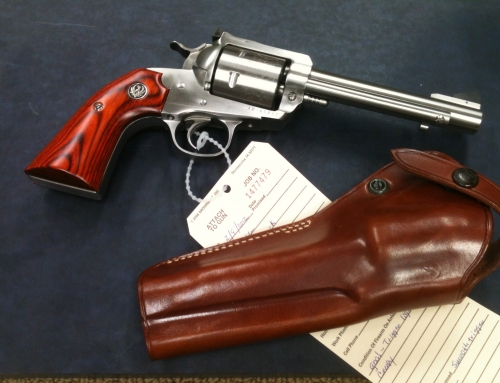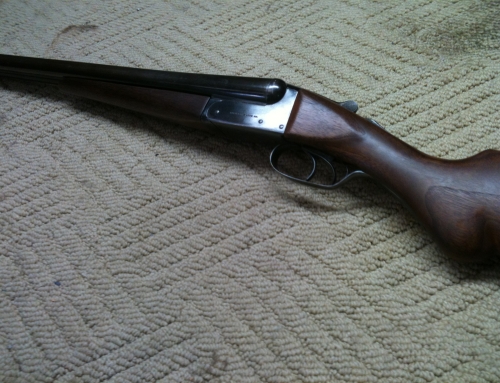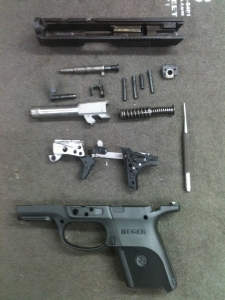 The Ruger SRc series has quickly become a best seller in the self-protection and concealed-carried-firearm market. It has also quickly generated a lot of comments about its trigger, including, creepy, rough, gritty, with a long reset and hard pull.
The Ruger SRc series has quickly become a best seller in the self-protection and concealed-carried-firearm market. It has also quickly generated a lot of comments about its trigger, including, creepy, rough, gritty, with a long reset and hard pull.
There are web suggestions about how to solve the problem (or decrease the problem), mostly involving cleaning and lubrication. There is, at least one, after-market trigger assembly part that is supposed to result in a significantly improved trigger for the gun. The Ghost 3.5 Rocket is a trigger control connector that replaces the OEM part and provides a shorter trigger pull and quicker reset by introducing a trigger control tab, TCT, on the connector that stops the trigger bar rearward movement. Installation is fairly simple, requiring a file and test, file and test type of procedure. Fitted on this gun, the tab started out at .340″, as supplied. After fitting it ended up at .270″. The connector is polished, unlike the parkerized OEM part and includes a couple of slots milled in the body that are supposed to be firing debris collection reservoirs to help keep foreign material from collecting between the trigger bar and the connector and causing trigger pull interference.
This device is good and does work as advertised. But, you have to read the information carefully to find out that the real trigger pull weight is likely to end up somewhere between 3.5 lbs and 5 lbs. I found that simply replacing and fitting this trigger connector does not solve the majority of rough or gritty trigger pull problems with the SR pistol fire control assembly. After fitting, the gun was still at 5 1/2 lbs trigger pull weight and very rough.
The reason is that the SR pistol has multiple moving surface interactions during the trigger pull that all can contribute to the pull weight and perception of roughness. In addition, there are several springs all being compressed or extended during the trigger pull, that all combine to impact the final pull weight.
For this pistol, as well at installing the Ghost connector, I elected to work on the various moving parts to identify and reduce the sliding surface friction and improve the rough pull, but not change or reduce spring weights in order to preserve the OEM configuration. Changing spring weights on these type of guns is not something to be monkeyed with unless a fair amount of action and response engineering is conducted first. Since there is little available from the manufacturer or after-market suppliers on spring modifications, I elected to not experiment. There is no fault in smoothing up the various interactive surfaces, however.
As provided, the gun’s action was well lubricated with a grease. It had been liberally applied at the factory to all of the moving parts. Grease is an effective lubricant and is often used when trying to smooth the travel of rough surfaces or to help keep a lubricant in place in larger clearance areas. It is not especially helpful, compared to a lighter lubricant, in allowing smooth surfaces to slide easily unless heated by friction. My first action was to run the various greased parts through an ultrasonic cleaner with Simple Green as the cleaning agent, blow out and heat dry.
Then I went to work with the buffer and smoothed up the trigger bar surfaces that slide in the frame and against the connector.
I buffed smooth the annular support bands on the striker assembly where they bear inside the slide tunnel. I buffed the surfaces of the firing pin safety block. This block is a horseshoe shape and moves up into a recess in the slide when the trigger is pulled. It has a lot of bearing surface where it rubs against the recess in the slide. It also is parkerized from the factory, a finish that contributes markedly to the feeling of roughness in the trigger pull as it is lifted into it’s recess. Making all of these surfaces mirror smooth goes a long way to improving the trigger pull feel. 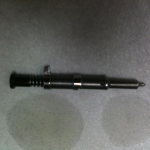 The two final surfaces to deal with here are the cam extension on the safety block and the cam surface on the trigger bar that pushes the on the block during the pull. These surfaces were polished bright.
The two final surfaces to deal with here are the cam extension on the safety block and the cam surface on the trigger bar that pushes the on the block during the pull. These surfaces were polished bright.
For a final surface polishing task, I marked the striker extension with layout fluid, assembled the gun and pulled the trigger a couple of times. On disassembly and inspection, I could see that the sear  wasn’t hitting the striker extension perfectly square. I corrected this by carefully filing and polishing the sear until the layout fluid showed an even removal pattern resulting from the trigger pull. Then I polished the sear surface of the striker extension and the end of the sear extension.
wasn’t hitting the striker extension perfectly square. I corrected this by carefully filing and polishing the sear until the layout fluid showed an even removal pattern resulting from the trigger pull. Then I polished the sear surface of the striker extension and the end of the sear extension.
After being satisfied that all of the interacting surfaces that move during the trigger pull were polished, at least on one side (I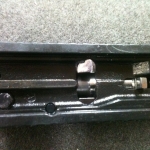 didn’t try to polish the internal slide recesses), I soaked the slide, striker assembly and complete trigger assembly in Break-Free CLP, a really good, silicone bearing lubricant, for a couple of hours, then wiped and blew out the excess. On the striker extension and sear, the trigger safety block and striker assembly bearing bands, as well as the trigger bar and connector surfaces that slide against each other and the internal frame surfaces, I applied Brownell’s Action Lube, a light, moly bearing grease.
didn’t try to polish the internal slide recesses), I soaked the slide, striker assembly and complete trigger assembly in Break-Free CLP, a really good, silicone bearing lubricant, for a couple of hours, then wiped and blew out the excess. On the striker extension and sear, the trigger safety block and striker assembly bearing bands, as well as the trigger bar and connector surfaces that slide against each other and the internal frame surfaces, I applied Brownell’s Action Lube, a light, moly bearing grease.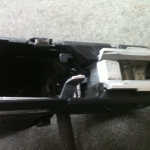
On reassembly, the trigger pull was truly smooth, with very little perception of sliding surface friction from the action and the trigger broke clean at a consistent 4 lbs. I cycled the action and pulled the trigger another 200 times and tested again, with the same results. Since the trigger pull on this gun has to move up the firing pin safety block, against the safety block spring, extend the  trigger return spring, compress the trigger bar lift spring and compress the striker spring, it is unlikely that the pull weight can be reduced any more. There are just too many springs and too many interactive surfaces to work against.This is probably as good as this gun is going to get.
trigger return spring, compress the trigger bar lift spring and compress the striker spring, it is unlikely that the pull weight can be reduced any more. There are just too many springs and too many interactive surfaces to work against.This is probably as good as this gun is going to get.
The trigger pull on these guns will never approach that of, even a well tuned Glock, XD or M&P, which are it’s primary competitors in the marketplace. It is also not a gun that I would recommend for any type of action pistol competition. The modification limits inherent in the fire control action and trigger pull can never result in that short and sweet trigger needed for the best in accuracy and speed competitions. However, for personal defense and protection at short distances, it should be reliable and go ‘bang’ when needed. You probably wouldn’t feel the trigger pull in that situation anyway.

